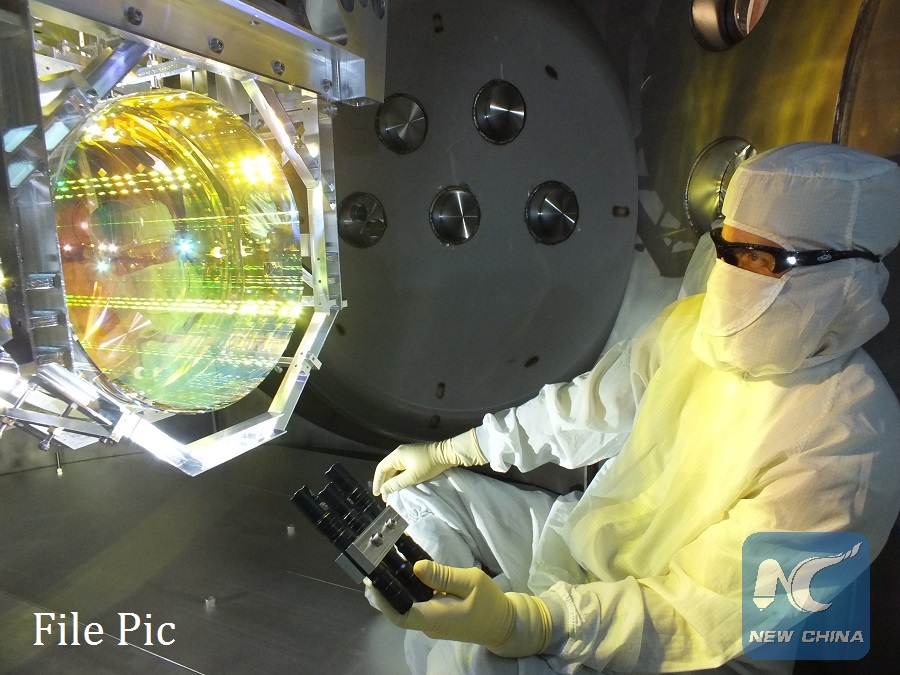
File photo shows a technician inspects one of LIGO's core optics (mirrors) by illuminating its surface with light at a glancing angles, prior to sealing up the chamber and pumping the vacuum system down. (Xinhua/Matt Heintze/Caltech/MIT/LIGO Lab)
by Fu Yiming, Li Jizhi and Zhang Xuan
STOCKHOLM, Oct. 4 (Xinhua) -- "It all started from the general relativity of Einstein about a hundred years ago," said Anders Irback, member of the Nobel Committee in Physics told Xinhua in an exclusive interview after Tuesday's announcement of 2017 Nobel Physics laureates.
"From that theory, gradually, an understanding on gravitational waves has been developed, accepted, that they should carry energy and should be possible to observe," he said.
As most have long expected, the discovery of gravitational waves crowns this year's Nobel Prize in Physics. The Swedish Royal Academy of Sciences announced on Tuesday in Stockholm that the Nobel Prize in Physics 2017 is shared by Rainer Weiss, Barry C. Barish and Kip S. Thorne, "for decisive contributions to the LIGO (Laser Interferometer Gravitational-Wave Observatory) detector and the observation of gravitational waves."
On Sept. 14, 2015, the universe's gravitational waves were observed for the very first time. The waves, which were predicted by Albert Einstein a hundred years ago, came from a collision between two black holes. It took 1.3 billion years for the waves to arrive at the LIGO detector in the United States, according to a statement from the Royal Swedish Academy of Sciences.
LIGO is a collaborative project with over 1,000 researchers from more than 20 countries. Together, they have realized a vision that is almost 50 years old.
The 2017 Nobel laureates have each been invaluable to the success of LIGO. Pioneers Weiss, Thorne, and Barish, who brought the project to completion, ensured that four decades of effort led to gravitational waves finally being observed.
Gravitational waves spread at the speed of light, filling the universe, as Einstein described in his general theory of relativity. They are always created when a mass accelerates, like when an ice-skater pirouettes or a pair of black holes rotate around each other. Einstein was convinced it would never be possible to measure them. The LIGO project's achievement was using a pair of gigantic laser interferometers to measure a change thousands of times smaller than an atomic nucleus, as the gravitational wave passed the Earth.
So far, all sorts of electromagnetic radiation and particles, such as cosmic rays or neutrinos, have been used to explore the universe. However, gravitational waves are direct testimony to disruptions in spacetime itself. This is something completely new, opening up unseen worlds.
In the press conference telephone interview, Weiss said the discovery had "added new knowledge and will open a new science in understanding our universe," praising the "dedicated works many scientists made for decades."
Another member of the Nobel Physics Committee, Olga Botner, said it was "a milestone, opening a window to the unknown universe. A dawn for the gravitational wave astronomy," she added.
In September 2015, the signal was extremely weak when it reached the Earth, but is already promising to revolutionize astrophysics. Gravitational waves are an entirely new way of observing the most violent events in space and testing the limits of our knowledge, the statement said.
Irback believe, not just for the scientific communities, the successful capture of gravitational waves should pump the excitement of all of us, not just because we are now able to, for the first time, measure the waves and better understand the unknown universe, also, "it's probably just a beginning."

